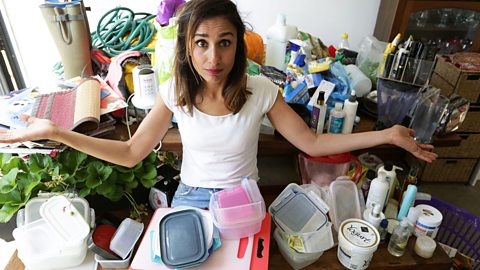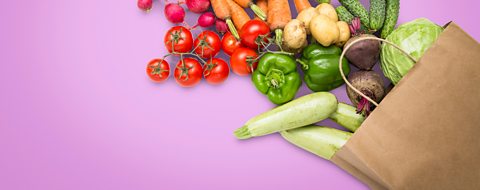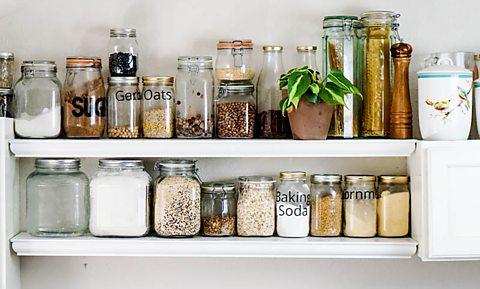Can you really have a plastic-free kitchen?

Is your kitchen bin or recycling overflowing with plastic bags, containers and produce wrapping? Plastic has become so commonplace that it’s easy to overlook how much of it you use and forget it doesn’t just disappear when it leaves your home.
, over 40 percent of which was single-use. Recycling helps to tackle the problem, but as seen on łÉČËżěĘÖ One’s War on Plastic with Hugh and Anita, not everything you put in the recycling is actually recycled.
How can you ditch plastic in favour of a more sustainable kitchen?
Which bag is best?
Once upon a time, the average person in England got through a year. We’ve slashed this by a staggering 86 percent, partly due to the and a heightened awareness of the detrimental effects of plastic on the environment. But major retailers in England still sold 1.75 billion plastic bags between April 2017 and April 2018.
When it comes to choosing a bag, do you know your options?
It takes as much energy to produce a paper bag as it does a plastic bag. Paper also weighs more than plastic, making transport emissions higher.
The Environment Agency paper bags need to be used at least three times to have lower global warming potential than standard plastic bags used only once. But paper bags do not tend to be reused. However, paper is recycled at a higher rate than plastic, so landfill is less of a problem.
By comparison, a bag for life, made of low-density polyethylene, needs to be used at least four times to have lower global warming potential than those standard plastic bags used just once. While this seems doable, it still adds to plastic pollution if you throw it away. Cotton bags need to be used 131 times, but they last well and cut down on plastic pollution dramatically.
Whatever type of bags you use, the key to minimising environmental impact is to use them as often as possible until they break and then return them to a supermarket bag collection point, which many chains now provide. Lots of these 'bins' also accept plastic wrap from bread, cereal boxes, toilet roll, freezer bags, ring-joiners and lots of other single-use plastic items. Ask in store if you’re not sure if your shop has one or what it accepts.

Is plastic ever better?
Some vegetables, such as , bananas, peppers and potatoes, and meats such as , can last much longer when wrapped in plastic. This is due to the oxygen-free environment or micro-climate that can be created.
So which is worse for the environment – plastic or food waste? We enter the plastic paradox.
, increasing the shelf life of produce by just one day would save UK shoppers up to ÂŁ500 million per year by cutting back on their food waste.
One way to avoid the need for long-life fresh ingredients is to shop for them locally so you can easily pop back when you want something. “Veg box deliveries and local markets or greengrocers are a way of ditching packaging while supporting local businesses”, says Emma Priestland, plastics campaigner at .
Kathryn Kellogg, the founder of and author of '101 Ways to Go Zero Waste', recommends shopping for whole foods rather than processed. "Most of the processed foods we buy come in a lot of packaging and fruits and vegetables tend to come with less. Bring your own container to buy meat and cheese from the deli and butcher. If available, you can also grab staples like nuts, grains and legumes from bulk bins”.
Pasta, rice and dried beans and pulses are often sold wrapped in plastic and if they weren’t they could be spoiled by water damage or breakage, creating food waste. If there is a plastic-free shop offering refill schemes near to you, you can take along reusable containers.
Many major UK supermarkets have pledged to reduce avoidable unrecyclable plastic packaging while slashing the amount of food waste produced. So in the future we could start seeing better alternatives and new solutions to plastic that increase shelf-life.

Utensils and storage
Utensils
“When it comes to spoons, spatulas, cutlery and everything else you use to cook and eat, opt for wooden or metal utensils. But don’t go to your kitchen right now and chuck out all your plastic utensils. Keep on using the plastic items you already have, and then when they reach the end of their life, look at replacing them with plastic-free alternatives”, says plastics campaigner Emma Priestland.
Lunch boxes
If you're taking your own food to work, school or college, you're already on the right track. Purchasing lunches such as sandwiches, soups and meals-to-go from shops involves a lot of single-use plastic. Reusing a box, no matter what it's made from, is key. “A steel lunchbox is perfect for taking your food to work – it won’t be prone to cracks or discolouring in the same way as a plastic one”, says Emma.
Clingfilm
For those who can afford them, beeswax wraps are an alternative to clingfilm – you can wipe them down and if the wax starts to come off or you accidentally melt it, you can recoat the wrap with wax yourself. However, the environmental impact of them at scale is not clear.
Freezer bags
It's best to freeze leftovers in reusable boxes rather than freezer bags or cling film. But try not to forget it’s in the freezer and label everything clearly so you know what you're defrosting!
Soda makers
If you buy a lot of bottled fizzy water or drinks, consider investing in a water carbonator. It will allow you to carbonate tap water instantly and store it in a glass bottle, rather than buying single-use plastic bottles.
The key is to use all your belongings until they break. When you have to buy something new, weigh up the options and decide what works best for you and the planet. Kathryn Kellogg says “of course, we don't live in a perfect zero-waste and plastic-free world. We can only do the best we can.”